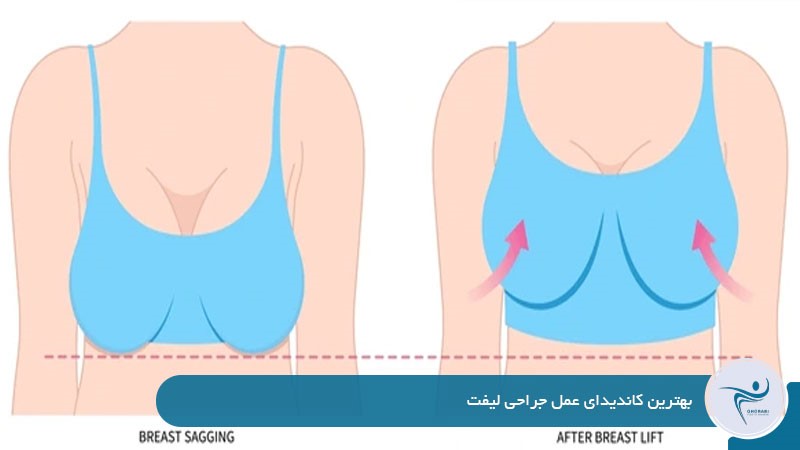جراحی ماستوپکسی یا عمل لیفت پستان که اغلب بهعنوان عمل سفت کردن سینه یا جراحی افتادگی سینه شناخته میشود، یک جراحی زیبایی پیشرفته برای بانوانی است که به دنبال بهبود فرم و موقعیت سینههای خود هستند.
این عمل با برداشتن پوست اضافی و تغییر موقعیت نوک سینه و آرئول، به سینهها ظاهری جوانتر و خوشفرمتر میبخشد. جراحی ماستوپکسی نهتنها افتادگی سینهها را رفع، بلکه به لیفت و کوچک کردن سینه نیز کمک میکند. متدهای مختلف جراحی ماستوپکسی براساس میزان افتادگی و فرم سینه هر فرد انتخاب میشود و نتیجه نهایی، افزایش اعتمادبهنفس و رضایت از ظاهر اندام خواهد بود.
روشهای لیفت سینه
روشهای لیفت سینه برای بهبود فرم و موقعیت سینههای افتاده طراحی شدهاند. این روشها با برداشتن پوست اضافی و تغییر موقعیت نوک سینه انجام میشوند. در زیر به برخی از روشهای رایج لیفت سینه اشاره شده است:

بهترین کاندیدای عمل جراحی لیفت سینه
بهترین کاندیداها برای عمل ليفت سينه یا ماستوپکسی افرادی هستند که به دنبال بهبود ظاهر و فرم سینههای خود بوده و ویژگیهای مشخصی داشته باشند. در این بخش بهصورت خلاصه به مهمترین این ویژگیها اشاره میشود:

- خانمهایی که سینههایشان به علت بارداری، شیردهی، یا نوسانات وزن دچار افتادگی و تغییر شکل شده است.
- افرادی که حجم سینههایشان مطلوب بوده و صرفا تمایل به رفع افتادگی و بالا کشیدن سینهها دارند.
- کسانی که از سلامت جسمانی کامل برخوردار بوده و فاقد بیماریهای جدی خطرساز هستند.
- بانوانی که در حال حاضر قصد بارداری ندارند؛ زیرا بارداریهای آتی نتایج عمل بالا کشیدن سینه را متاثر میکند.
- اشخاصی که انتظار واقعبینانه از نتایج عمل ماستوپکسی داشته و درک درستی از محدودیتهای آن دارند.
- افرادی که سیگار نمیکشند یا قادرند مصرف دخانیات را برای دوره قبل و بعد از عمل قطع کنند.
- کسانی که وزن نسبتا پایداری دارند، چرا که تغییرات وزن بالا شکل سینهها پس از عمل را تغییر میدهد.
- بانوانی که برای انجام عمل بالا کشیدن سینه انگیزه شخصی داشته و به دنبال افزایش اعتمادبهنفس هستند.
توجه داشته باشید که عمل ژنیکوماستی، برخلاف عمل ماستوپکسی که برای زنان است، به جراحی برای کوچک کردن سینه مردان اطلاق میشود و کاندیداهای متفاوتی دارد.
هزینه عمل ماستوپکسی
هزینه عمل ماستوپکسی، یا همان جراحی لیفت سینه، یک مبلغ ثابت و مشخص نیست و بسته به عوامل متعددی متغیر است. نمیتوان بهطور قطعی یک رقم واحد را بهعنوان هزینه بالا كشيدن سينه اعلام کرد. از جمله مهمترین عوامل تعیینکننده هزینه جراحی لیفت سینه عبارتاند از:
- دستمزد جراح پلاستیک
- هزینه متخصص بیهوشی
- هزینههای بیمارستان یا کلینیک
- موقعیت جغرافیایی مرکز جراحی
- پیچیدگی عمل و نوع تکنیک ماستوپکسی مورد استفاده
برای اطلاع دقیق از هزینه نهایی و متناسب با شرایط شما، توصیه میشود با جراح زیبایی مشورت کنید تا پس از معاینه و بررسیهای لازم، برآورد دقیقتری ارائه شود.
ماستوپکسی پیشرفته با بهترین نتیجه توسط دکتر غرابی
دکتر غلامحسین غرابی با ارائه ماستوپکسی پیشرفته، تحولی نوین در جراحی لیفت سینه ایجاد کرده است. ایشان با بهرهگیری از تکنیکهای مدرن و رویکردی کاملا شخصیسازیشده، نتایجی بینظیر و طبیعی را برای بیماران خود به ارمغان میآورند. تخصص دکتر غرابی در ظریفترین جزئیات ماستوپکسی، تضمینکننده لیفت دقیق، فرمدهی هنرمندانه و به حداقل رساندن جای زخم است. بیماران دکتر غرابی از تجربه بهبودی راحتتر و نتایج ماندگار و زیبای عمل لیفت سینه خود شگفتزده میشوند. انتخاب دکتر غرابی، قدمی مطمئن به سوی زیبایی و اعتماد به نفس بیشتر است.
About DR. Ghorabi
با دکــتر غــرابی آشـــنا شــویـد

About DR. Ghorabi
با دکــتر غــرابی آشـــنا شــویـد

عضو رسمی انجمن جراحان پلاستیک و زیبایی آمریکا

عضو رسمی انجمن جراحان پلاستیک و زیبایی بین المللی

عضو رسمی انجمن جراحان پلاستیک و زیبایی ایران
ســـوالــات مــــتداول
انواع روشهای عمل لیفت سینه کدامند و چه تفاوتی دارند؟
روشهای اصلی شامل هلالی، دایرهای، عمودی و لنگری میشوند. تفاوت در میزان برش، جای زخم و میزان افتادگی اصلاح شده است که جراح تعیین میکند.
چه کسانی کاندیدای مناسب عمل ماستوپکسی محسوب میشوند؟
خانمهایی با افتادگی سینه ناشی از بارداری، شیردهی یا کاهش وزن که سلامت عمومی خوبی داشته و انتظار واقعبینانه از نتیجه دارند.
هزینه عمل لیفت سینه به چه عواملی بستگی دارد؟
هزینه متغیر است و به دستمزد جراح، نوع بیمارستان، موقعیت جغرافیایی، پیچیدگی عمل و نوع تکنیک جراحی بستگی دارد. مشاوره برای برآورد دقیق لازم است.
دوره نقاهت عمل ماستوپکسی چگونه است؟
دوره نقاهت شامل درد، تورم و کبودی است. بهبودی اولیه چند هفته و بهبودی کامل تا چند ماه طول میکشد. استراحت و مراقبتهای پزشکی مهم هستند.
نتایج عمل لیفت سینه تا چه مدت ماندگار است؟
نتایج طولانیمدت است، ولی تغییرات وزن، بارداری و افزایش سن بر فرم سینه در طول زمان تاثیر میگذارد. حفظ وزن ثابت و سبک زندگی سالم مهم است.


